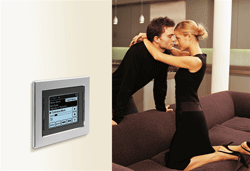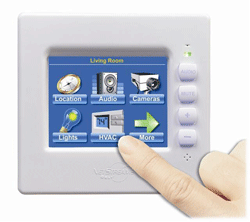 Essentially, the function of a home automation system is to automate your home and activate events involving various systems and components, achieved by triggering one simple command. Although a relatively new technology, especially here in South Africa, it is believed that in the not too distant future, home automation will be the norm in most residential homes around the globe.
Essentially, the function of a home automation system is to automate your home and activate events involving various systems and components, achieved by triggering one simple command. Although a relatively new technology, especially here in South Africa, it is believed that in the not too distant future, home automation will be the norm in most residential homes around the globe.The benefits of a home automation system are many, as they have the ability to automate your entire home –
 activating actions and habitual routines that entail, among other things, light fixtures, security components, heating/cooling systems based on the time of day, or any other condition that you select. For example, when you are leaving your home, you could activate the "Away" button to fully activate the security system, set the thermostat to an energy-saving level, turn on various lights, and turn off any audio/visual equipment or other appliances. When you return, you simply press the "Home" button to activate all the necessary lights, heating, audio/visual equipment, and deactivate the full alarm.
activating actions and habitual routines that entail, among other things, light fixtures, security components, heating/cooling systems based on the time of day, or any other condition that you select. For example, when you are leaving your home, you could activate the "Away" button to fully activate the security system, set the thermostat to an energy-saving level, turn on various lights, and turn off any audio/visual equipment or other appliances. When you return, you simply press the "Home" button to activate all the necessary lights, heating, audio/visual equipment, and deactivate the full alarm.An automation system comprises many sub-systems that it controls.
 Sub-systems are made up of one system in the home, such as security, temperature control, lighting, audio/visual equipment, pool and spa bath control, motorised curtains, various appliances, and so on. As per its definition, a home automation systems is made up of a minimum of two sub-systems, which it controls and allows the homeowner to put several commands into action at a simple press of a button. For example, when you wake up in the morning, you can press the "Awake" button, which can deactivate the full security system, switch on the coffee machine, TV, heating and radio, as well as automatically open all the curtains in the home.
Sub-systems are made up of one system in the home, such as security, temperature control, lighting, audio/visual equipment, pool and spa bath control, motorised curtains, various appliances, and so on. As per its definition, a home automation systems is made up of a minimum of two sub-systems, which it controls and allows the homeowner to put several commands into action at a simple press of a button. For example, when you wake up in the morning, you can press the "Awake" button, which can deactivate the full security system, switch on the coffee machine, TV, heating and radio, as well as automatically open all the curtains in the home. The majority of home automation systems are made up of a central processing unit (CPU) and various user interfaces. The CPU is normally hidden out of site and serves as the brains of the entire system. The various sub-systems communicate with the CPU, which in turn communicates and interacts with the homeowners via various interfaces such as touchscreens, handheld remotes or a PC. There are many various types of home automation systems, with varying degrees of intelligence, ease of programming, levels of flexibility, intuitiveness of operation, communications media employed, price and other features.
The majority of home automation systems are made up of a central processing unit (CPU) and various user interfaces. The CPU is normally hidden out of site and serves as the brains of the entire system. The various sub-systems communicate with the CPU, which in turn communicates and interacts with the homeowners via various interfaces such as touchscreens, handheld remotes or a PC. There are many various types of home automation systems, with varying degrees of intelligence, ease of programming, levels of flexibility, intuitiveness of operation, communications media employed, price and other features.  The more affordable home automation systems, offer basic control features for two or more integrated sub-systems. They usually connect directly to the item they are controlling, and do not interface with the entire system, and the majority of these systems usually start off as an advanced security system that has been added to. This underlines the biggest benefit of a moderately priced system – as they can initially be installed at a comparatively low cost, to which you can integrate other components as finances allow, instead of outlaying a sizeable amount to install an entire system upfront. On the negative side however, most moderately priced home automation systems do not have the capacity to integrate sophisticated light-diming systems or home entertainment technology.
The more affordable home automation systems, offer basic control features for two or more integrated sub-systems. They usually connect directly to the item they are controlling, and do not interface with the entire system, and the majority of these systems usually start off as an advanced security system that has been added to. This underlines the biggest benefit of a moderately priced system – as they can initially be installed at a comparatively low cost, to which you can integrate other components as finances allow, instead of outlaying a sizeable amount to install an entire system upfront. On the negative side however, most moderately priced home automation systems do not have the capacity to integrate sophisticated light-diming systems or home entertainment technology. The top-end home automation systems are loaded with a number of various bells and whistles and lay claim to offering homeowners a number of customisable functions and features, as well as top-end user interfaces. The price tag on these systems may be exceptionally sizeable, but in the end, you get what you pay for, as these systems can virtually integrate any sub-system in the home into a seamless and easy to use home control network. Sophisticated dimming capabilities and automating audio and video equipment usually contributes to the biggest expense of a high-end home automation system.
The top-end home automation systems are loaded with a number of various bells and whistles and lay claim to offering homeowners a number of customisable functions and features, as well as top-end user interfaces. The price tag on these systems may be exceptionally sizeable, but in the end, you get what you pay for, as these systems can virtually integrate any sub-system in the home into a seamless and easy to use home control network. Sophisticated dimming capabilities and automating audio and video equipment usually contributes to the biggest expense of a high-end home automation system. With home automation, your home can become an active partner in the running of your everyday life – saving you time and money, and adding significantly to your lifestyle.
Pictures
Images courtesy of Homemation.
For more information contact Homemation 0861 102 505 or click here to visit the website.
Property News
Click here for more property news articles.
Need a blog?
Start your own blog with a free blog from 24.com.








